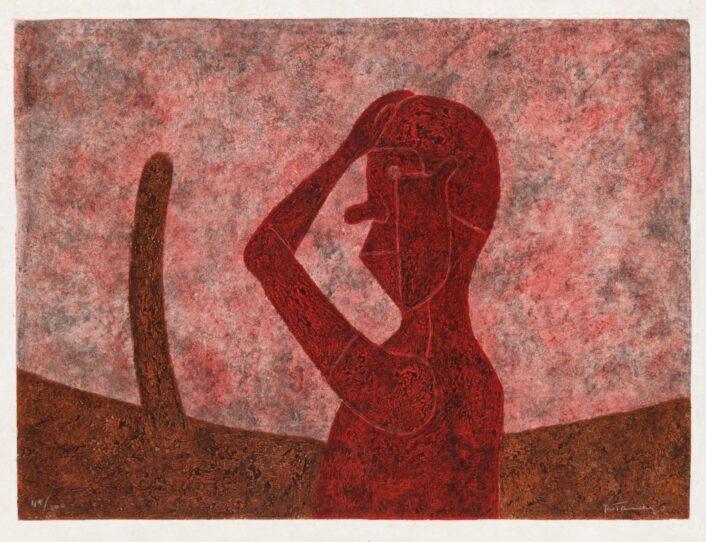Fine Art
Rufino Tamayo and printmaking
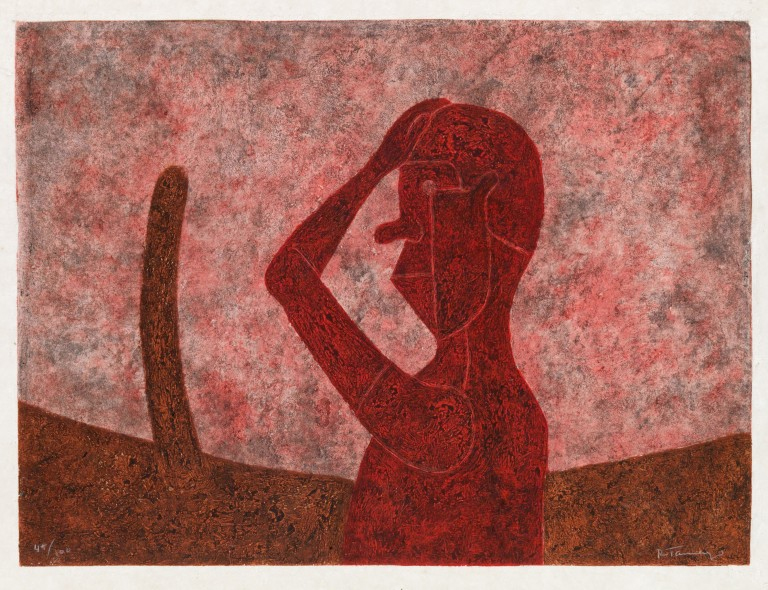
“Busto en Rojo,” Mixografia, 1984.
Image courtesy of: Swann Auction Galleries
The Mexican modern art master, Rufino Tamayo, is best known for his work as a painter and muralist; however, it is important to remember his connection to Mixografia. Tamayo was instrumental in developing this technique in the early 1970s in order to allow him to produce his prints in relief. This unique process involved one instrumental piece, a three-dimensional plate that Tamayo developed with the help of a master printmaker.
The artist was born in Oaxaca, Mexico and initially trained at the School of Fine Arts in San Carlos. However, Tamayo quickly became frustrated with the school’s traditional teaching methods. Soon thereafter, he became head of the Department of Ethnographic Drawing at the National Museum of Anthropology in Mexico. Tamayo’s time at the museum ignited his interest in pre-Columbian art and had a lasting influence on his work throughout his long career.
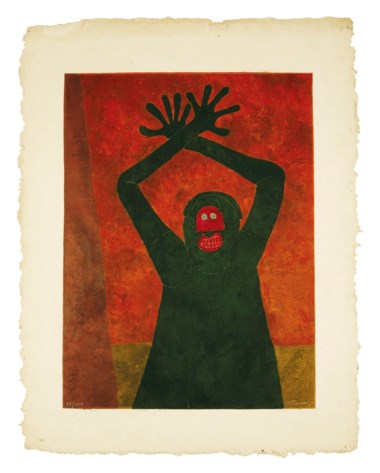
“Protesta” from Christie’s Latin American Art Online sale, November 2018. The 10 Mixografia prints were sold at the auction came from the Los Angeles County Museum of Art’s collection in order to benefit Latin American art acquisitions.
Dimensions are: 38.75″ x 30.50″
Image courtesy of: Christie’s
The artist came from Zapotec descents and spent time living in Mexico at the beginning of the 20th century. The famous Mexican artists of the time were mainly muralists, especially Diego Rivera, but their art was too political and too large for Tamayo’s taste. He moved to New York City in the 1920s, and was instantly influenced by the works of Matisse, Picasso, Braque, and other artists involved in the modern art movement.
Unique to Tamayo was that he combined traditional Mexican styles with current European trends. The artist was especially adept at presenting his indigenous Zapotec ancestry to the outside world. Beautifully, Tamayo melded both styles and the end result was unlike anything else artists were producing at the time. His work was both ingenious and honest.
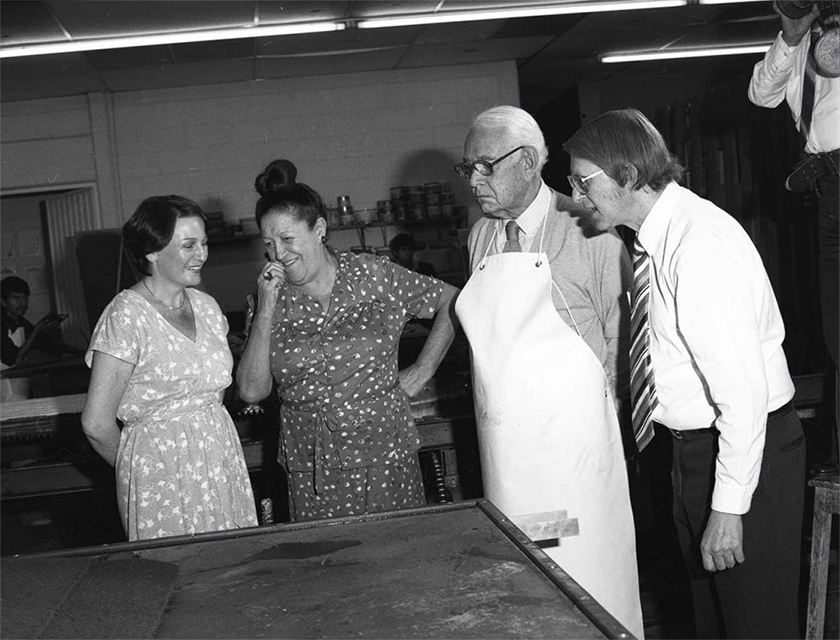
Lea Remba, Olga Tamayo, Rufino Tamayo and Luis Remba at Mixografia, 1980-85.
Image courtesy of: 1st Dibs, photographed by: Shaye Remba
1973 proved to be an instrumental year for Tamayo as he was invited by Luis Remba to collaborate on a collection of prints at Taller de Grafica Mexicana (the studio which was run by Luis and Lea, Luis’ wife). Remba was a lithograph and printmaker; the collaboration with Tamayo led to a completely new print medium named Mixografia. The new technique allowed Remba to create prints in relief… this was a direct response to Tamayo’s ambitions.
Working mainly in prints, Tamayo loaded up his surfaces with thick impasto and incorporated other materials into the evolving pigment. The heavy material became too much for conventional paper. He quickly began to press his own paper onto which he could add more materials and textures. What resulted was as much print as sculpture; and it gave off the appearance of pre-Columbian stone reliefs. As it evolved, Mixografia involved a number of steps and materials including burnt wood and molding plasticine.
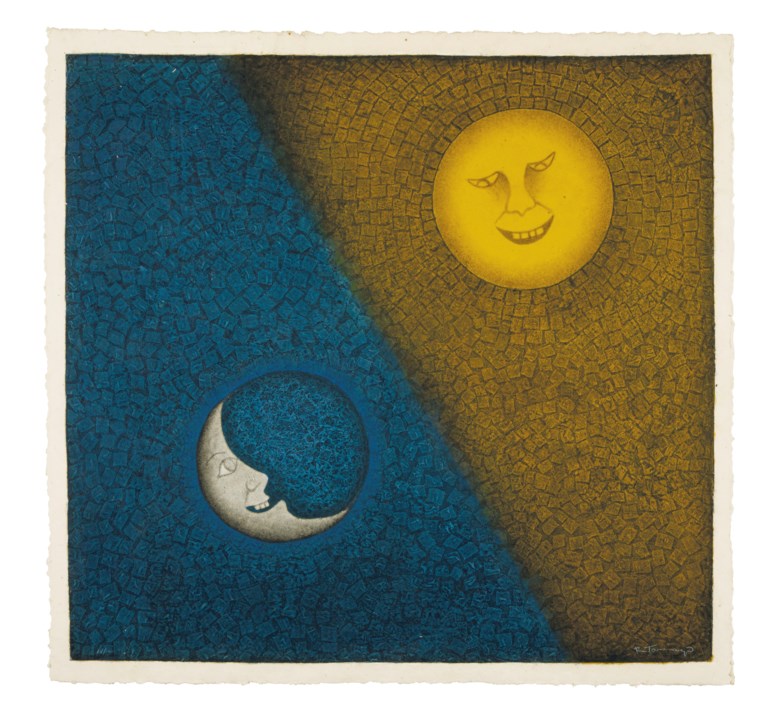
“Luna y sol” was Tamayo’s final painting in 1990. The piece comes from Christie’s Latin American Art Online sale.
Dimensions are: 37.25″ x 39.25″
The blue contrasts with the bright yellow while the faint black lines create a sense of depth. Even thought this is a two-dimensional plane, the moon and sun appear to be receding into the distance.
Image courtesy of: Christie’s
The process of Mixografia begins in a way similar to that of traditional printmaking. The artist crafts a model using a variety of materials from which a plate is cast and covered in a layer of ink. Up until now, these two processes remain the same… now they differ.
Rather than pressing the plate against a sheet of paper, a paper pulp (made in-house from cotton fiber), is applied on top of the print ink. The paper pulp and plate are placed under extremely high pressure which allows the pulp to slide into each inch and crease of the plate and the ink is able to mix into the pulp’s fibers.
Mixografia was perfect for what Tamayo hoped to achieve. The end result is a print that becomes richer in color as the ink becomes immersed in the paper’s fabric. The surface possesses complex qualities and resembles a relief… unlike a typical two-dimensional print.

“Dos Personajes Atacados Por Perros (“Two People Chased by Dogs”), 1983. Shown as part of “Dimensions of Form: Tamayo and Mixografia” organized by the Bowers Museum in conjunction with Mixografia.
The scene suggests the expulsion of Adam and Eve from Eden. Produced during the last decade of Tamayo’s career, this is the largest lithography stone ever produced. At over 7 feet long, it is the size of a wall mural. Luckily, this lithograph is still on display at Mixografia’s studio, partially because it is too large and heavy to be moved.
About the print, Kaplan said, “It can be read as a response to the state of the world in that period, with pervasive feelings of angst and anxiety.”
Image courtesy of: LA Times
Rachel Kaplan, assistant curator of Latin American Art at Los Angeles County Museum of Art said about Tamayo, “Tamayo’s prints span the seven decades of his career, and from very early on he was combining techniques to push the medium in new directions. Now, almost three decades after his death, the Mixografia technique he envisioned continues to develop and evolve, with contemporary artists adopting the process.”
Tamayo had a unique ability to tap into his emotions… all his pieces have a dreamy quality to them. Spending time in his native Mexico, as well as the United States and Europe, Tamayo was deeply affected by Cubism, Expressionism, and Surrealism. What resulted is a legendary career that lasted for many decades and that prompted the development of a three-dimensional plate that ensued in richly textured prints. Thank you Rufino Tamayo!
